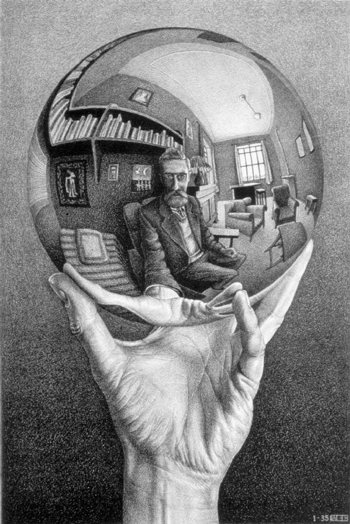
Hand with Reflecting Sphere

|
In the lithograph Hand with Reflecting Sphere depicted in 1935, Escher is seen holding the sphere in his hand (which is itself reflected) so that he also has himself and his studio “in hand”. To Escher, the mirror image was no ordinary matter. He was fascinated by the mixture of the one reality (the mirror itself and everything surrounding it) with the other reality (the reflection in the mirror) as seen with this work of art.
In the picture Hand with Reflecting Sphere, Escher depicts a spherical mirror, resting on a left hand. But as a print is the reverse of the original drawing on stone, it is really the right hand being depicted. (Escher was left-handed, so he needed that hand to make the drawing).
In this mirror, all of his surroundings are compressed, albeit distorted, into that one small circle, including his studio, four walls, floor, ceiling and even a self portrait of himself.
The artist’s head, or more exactly the point between his eyes, is in the absolute center. No matter how you turn or twist yourself, you will always see him as the central point of the image.
Hand with Reflecting Sphere is one of Escher’s most recognized works. His fascination with spherical-mirror prints can be seen throughout his career. Escher's preoccupation with mirrored reflections and visual illusion belongs to a tradition of northern European art established in the fifteenth century. He employed mirror images to express metaphysical ideas as well as to create a sense of order. Reflection could demonstrate dualities of the conscious and unconscious world, reality and fantasy, truth and falsehood, and, ultimately, conflicting spatial points of view.












